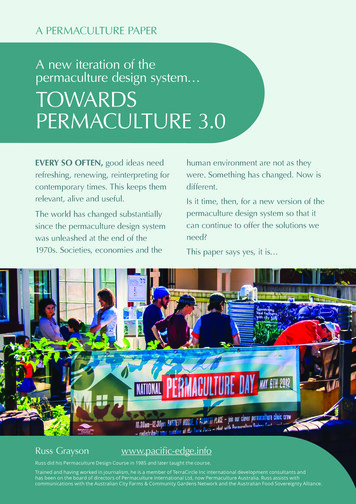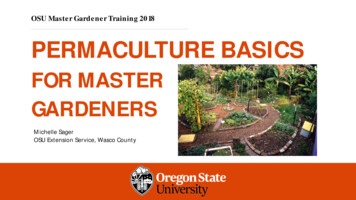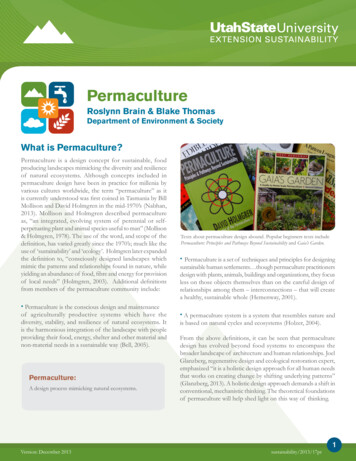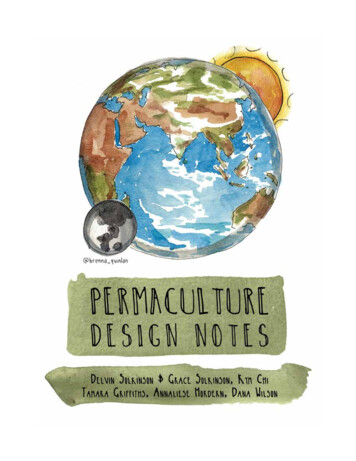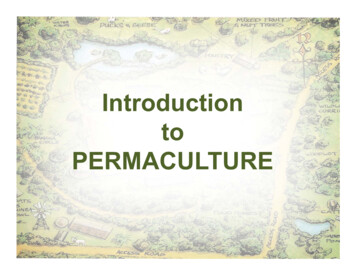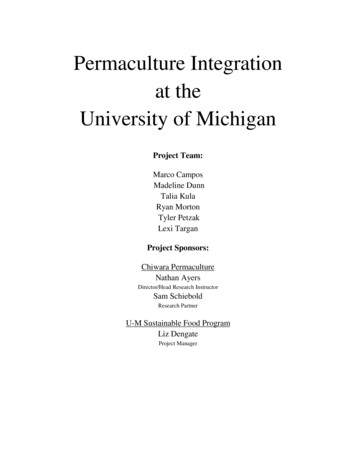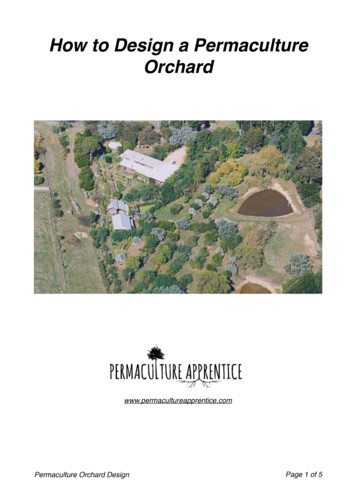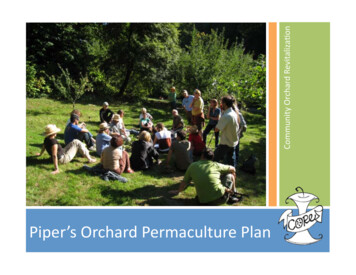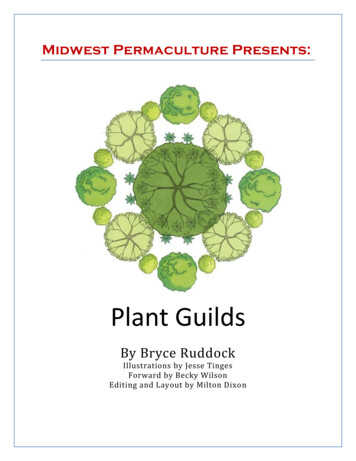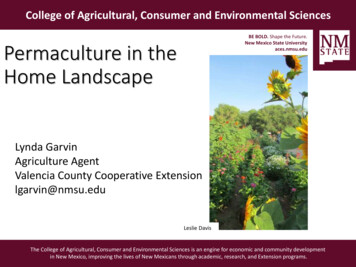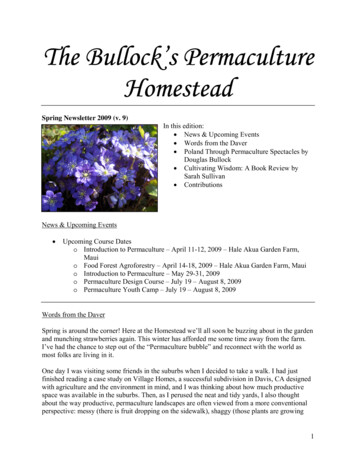
Transcription
The Bullock’s PermacultureHomesteadSpring Newsletter 2009 (v. 9)In this edition: News & Upcoming Events Words from the Daver Poland Through Permaculture Spectacles byDouglas Bullock Cultivating Wisdom: A Book Review bySarah Sullivan ContributionsNews & Upcoming Events Upcoming Course Dateso Introduction to Permaculture – April 11-12, 2009 – Hale Akua Garden Farm,Mauio Food Forest Agroforestry – April 14-18, 2009 – Hale Akua Garden Farm, Mauio Introduction to Permaculture – May 29-31, 2009o Permaculture Design Course – July 19 – August 8, 2009o Permaculture Youth Camp – July 19 – August 8, 2009Words from the DaverSpring is around the corner! Here at the Homestead we’ll all soon be buzzing about in the gardenand munching strawberries again. This winter has afforded me some time away from the farm.I’ve had the chance to step out of the “Permaculture bubble” and reconnect with the world asmost folks are living in it.One day I was visiting some friends in the suburbs when I decided to take a walk. I had justfinished reading a case study on Village Homes, a successful subdivision in Davis, CA designedwith agriculture and the environment in mind, and I was thinking about how much productivespace was available in the suburbs. Then, as I perused the neat and tidy yards, I also thoughtabout the way productive, permaculture landscapes are often viewed from a more conventionalperspective: messy (there is fruit dropping on the sidewalk), shaggy (those plants are growing1
over one another), and a maintenance nightmare (who has time to care for all those plants?).Even at Village Homes, upon looking at the largely illegible landscape, some people state, “Itlooks like a slum.”Reading Josho Somine’s article in the last newsletter (Autumn 2008 – v. 8) and taking a freshlook at the mainstream has made me ponder a few questions:Does permaculture design need to flex to appeal to conventional aesthetics? If so, how should itchange and what happens when sustainability and aesthetics conflict? Conversely, doconventional aesthetics need to change to recognize the beauty of less “tidy and orderly”landscapes? If so, how can that aesthetic shift be accomplished?At first blush seems like the age old battle of form versus function. However, analyzing theproblem critically seems to indicate that the problem can, and seemingly must, be approachedsimultaneously from two angles: 1) Changes in permaculture design and 2) Changes in people’saesthetics. Working toward this crossover point between sustainability and aesthetics isincredibly important if Permaculture Design is to remain relevant in a future offering more andmore solutions to our present “unsustainable” state.1) Changes in Permaculture DesignOne thing is for sure. If permaculture design is going to be relevant in the future of design it willhave to meet people where they are at on a number of fronts. A designer will not be able toimpose a productive, lush, verdantpermaculture landscape into your averagesuburban yard without acknowledgingdominant attitudes with regard to aesthetics,property values, and maintenance.The dominant aesthetic we see in landscapestoday speaks to order and organization.Everything is in the right place and it is neatlyseparated from everything else. Many of theplants serve specific aesthetic functions such aswinter bloomers, dense foliage for screening,and accents along paths or around trees. Withregard to non-plant elements we often seebrightly colored beauty bark, concretepathways, and strategically placed rocks.Instead of trying to convince a homeowner toreplace this with a jungle-like food forest,perhaps a designer would meet with moresuccess by starting small. Try adding in someplants that are both productive and widelyacknowledged as attractive (e.g. rosa rugosa,2
chives, culinary sage, etc.). Perhaps one could replace the concrete paths with pavers orpermeable material to encourage groundwater infiltration. In this way designers can begin toslowly move toward productive landscapes without creating a landscape where the owner doesnot comprehend the beauty.Concerns regarding property values are very challenging to address. To some extent the veryidea of commoditizing land leads to abuse. The idea of land as an investment, unless temperedwith ethics, usually results in a degraded landscape. However, this is still a very real parameterfor any permaculture designer today. If you provide a design that a causes a homeowner to worryabout their property values they may choose not implement it. Similarly, if your design leads to alandscape that affects neighbors property values you could inadvertently create friction in theneighborhood. Our designs should seek to enhance community, not damage it.Therefore, if we place property values into the permaculture designer’s design brief, he or shemust be prepared to preserve or enhance them in most cases. There are a variety of ways toaccomplish this. For example, a designer can speak with neighbors about his or her design ideasso they know what is coming and can have input. Designers may also want to become familiarwith any covenants or rules that have been imposed by neighborhood or condominiumassociations. If a designer wants to do something outside these parameters (without creating astink) it seems prudent to speak to the community.Another obstacle that permaculture designers face today is maintenance for the landscapes theydesign. People today are busy. In most cases people are seeking low maintenance systems sothey can minimize their input of time and money. Unfortunately, it is easy to design systems thatrequire quite a bit of maintenance (at least until they are established).Perhaps it would be best to reserve the higher maintenance systems for clients who are ready forit. By sticking to a palette of plants and landscape elements that will require minimalmaintenance for the average client a designer will provide a landscape design that does notoverwhelm a homeowner’s agenda or pocketbook. The happier that homeowner is the morelikely they will be open to suggestions in the future.However, it seems that while low maintenance is good, allowing some opportunities for ahomeowner to interact with their landscape may pay off in the future. If you can create alandscape that requires a small amount of enjoyable interaction from the homeowner (e.g.harvesting raspberries, chopping green manure crops, and for some, pruning) you may actuallydo them a favor in terms of exercise, time outdoors, and healthy interaction with nature.2) Changes to our Conventional AestheticsWhile permaculture designers definitely need to understand and incorporate an understanding ofconventional aesthetic issues into their designs, it is also important to work on the other end ofthe issue and do what is possible to help shift the conventional landscape aesthetic to somethingthat more closely resembles a natural system. Methods for accomplishing this include increasingclients’ understanding of ecology, teaching people to use senses other than vision wheninteracting with a landscape, and incorporating clients into the design process.3
Currently, there is a great deal of literature addressing the psychological, physiological, andsociological effects of our culture’s lack of connection to Nature. In tandem with a lack ofunderstanding of basic ecological principles, this forms a foundation for the dominant aestheticwe see in most landscapes today. If one improved his or her understanding of the hydrologiccycle they would be better equipped to comprehend the relationships between seeminglydisparate things such as groundwater recharge, impervious surfaces, pesticide use, and thequality of what comes out of the faucet.In order to increase people’s understanding of ecology each and every permaculture designermust acknowledge their role as an educator. If your clients understand some of the basics ofecology they will be better equipped to look at a landscape through the lens of permaculture.This can be accomplished simply through talking with clients. Why not suggest a picnic for yourinitial meeting? You will have a classroom all around you. Permaculture designers can also takesteps to help the general public understand ecology by offering classes and workshops. Bystepping into the role of educator in addition to designer, one can deepen the understanding ofthose in the community while publicizing his or her design services.Another shift that would helppeople to become moreaccustomed to permaculturelandscape aesthetics is, in manyways, a return to childhood.Too often it is only childrenplaying outside that take thetime to stop and sniff a lilac infull bloom, snack on a fennelplant growing in the yard, ornotice the clacking sound ofwind blowing through abamboo grove. Too often adultsare so busy that the onlyinteraction they have with theirlandscape is glancing at it ontheir way to the car or mowingthe grass once a week.What if designers took their clients to arboretums and nurseries in order to “test drive” their othersenses? What if we encouraged people to touch, taste, and smell the plants we suggest for them.The sense of smell alone has an incredibly strong effect on people, with the ability to calm themor bring them to tears with nostalgia. Remind your clients that can have rich textures that gobeyond just the visual. They may even thank you for the reminder.Finally, if permaculture designers want to see more sustainable landscapes it is crucial toincorporate clients into the design process. As a design system permaculture provides us with aset of steps to take in order to create a design, a set of principles to use as filters for decision-4
making, and design methodologies to help think outside the box. By incorporating clients inevery step of the process they will doubtless feel like they are more a part of the outcome. If thedesigner creates their design in an office somewhere and brings in the client when the process isdone it is far more likely that key pieces will not suit the client.There are many ways to get clients involved. For small projects, it could be as simple aschecking in with a client at each step of the design process to make sure that you are both on thesame page. It could also involve educating the client about why the designer made each decision.By proxy, this involves teaching the client a bit about permaculture, which can go a long way.For large projects that will affect a broad range of people in the community processes exist to getthem on board. Design charrettes are a tool that can help bring together all stakeholders in acommunity and make sure they are heard. The design that results from the charrette process isoften much better received than the one done without public input.Indeed, it is only through working on both the responsiveness of our permaculture designs toconventional aesthetic concerns and working to shift those mainstream aesthetics toward themodels we see in Nature that permaculture designers will be able to see their work increase inprominence. If the permaculture design community can accomplish aesthetic shifts bothinternally and externally we can begin to look forward to a future in which sustainablelandscapes are the norm, not the exception.That’s all for this newsletter. Hopefully everyone is enjoying the dregs of winter. Spring isstarting to happen here, so I need to get moving on the garden. You probably do too!DaverPoland Through Permaculture Spectacles: Examples for Europe & Beyond by Douglas BullockThrough our several visits to Poland during its transition into the EU, I have had the chance tosee several outstanding examples of building and agricultural practices of the past. Many of theseclimate-appropriate practices could be incorporated into sustainable urban systems, permaculturefarms, and eco-villages of the future throughout Poland, Central Europe, and similar places inNorth America. Most of these examples persist not only in Poland, but scattered throughoutCentral Europe. I hope you enjoy this sampling of techniques that you may find useful in yourown permaculture endeavors.Like much of North Central Europe, Poland is blessed with a mild summer and about 25 inchesof rain distributed throughout the growing season. Large areas of excellent soils have fosteredmajor farm production for centuries. Most of this production has occurred on small family farms,many of which are now changing as young people depopulate the countryside in search of theglittering trinkets so seductively proffered by the modern corporations in Poland’s urban centersand the cities of Western Europe.Markets5
Open air markets and roadside vendors were ubiquitous. These markets were equally likely to befound along the highway in the hinterlands or in downtown Warsaw (3.5 million people)adjacent to a modern financial district. Wherever they were, these markets provided incrediblydiverse offerings ranging from masses of local produce and wild-crafted mushrooms to cheapChinese clothes and hardware. Other notable offerings included fresh-baked breads, a variety ofsauerkrauts, and wicker baskets and furniture.At the open air markets there were often mobile bicycle shops on trucks or trailers that sold newand used bikes, parts, and handled repairs on the spot. You could get your bike repaired whileyou shopped. There were also many vendors of nursery stock, such as bare root fruit and nuttrees, shrubs, and vines, doing brisk business in the autumn. Some of the markets even had localforged farm and garden tools, which seemed to be holding their own against inexpensive Chineseimports.Occasionally, these markets also had a large area for selling small farm animals includingchickens, ducks, quail, rabbits, and other stock. They also offered animal feed, cages, andhutches so you could find everything needed to get your home flock or farm up and running.Overall, most of the produce was local, fresh, and relatively chemical-free. The only notable itemI thought was lacking in the markets was a diversity of greens. One notable point of diversity,especially greens, came from the small Vietnamese population. As one might expect, diversedietary traditions lead to increased diversity in market offerings. Vietnamese folks at the marketsoften sold fresh sprouts, greens, tofu, and a variety of tropical fruit flown in from Asia.Allotment GardensIn and around Poland’s largerurban areas exist “Działki”(pronounced ‘jauky’) orallotment gardens. Thesegardens were established 50-60years ago as rural peoplemoved into the industrializingcities. The new “robotnik”(factory workers) weredissatisfied with the lack ofgood food and connection toearth. So, large allotmentgardens were established.Often the land was owned by afactory. As a worker in thatfactory one would be assigneda plot where they could growfood and have some access to bucolic surroundings. Perhaps it was a perk. However, it alsoserved as a way to keep people from leaving and returning to a rural existence.6
Today, many of these allotment gardens still exist. Poland’s allotment gardeners are wellorganized with meetings, political strength, and a good national magazine specifically focusingon organizing, gardening tips, and resources for gardeners.Much larger in scale andnumbers than communitygarden plots in North America,these “jauky” or allotmentsexist throughout the formerSocialist Republics and theyrock! Laid out on a grid, theallotment gardens often lookmuch like a mini subdivision. Infact, each allotment oftencontained a tiny house or toolshed hidden in a forest gardenof useful, functional trees,shrubs, vines, and animals. Anamazing amount and diversityof high quality produce comesfrom these gardens. Crops Icommonly saw in allotment gardens included nuts (walnuts and hazelnuts), seeds and grains(rye, buckwheat, sunflower seeds), and fruits and vegetables (cabbage, potatoes, plums, pears,and tomatoes). This local food production meant that people consumed fewer packaged foods offsupermarket shelves (actually there were far fewer supermarkets).ForestryGreenspace and large, established parks exist throughout the cities and small towns. These parksoften connect with a forested buffer on the urban periphery. Frequently, forested areas could alsobe found adjacent to riparian areas running through town or city. In all, the line between forestand city was a blurry one.In sandier soils, forests tended to be characterized by pines (usually Pinus silvestris) planted fortimber harvest. In the understory a deciduous mix of broadleaf forest species including oak,cherry, beech, birch, and others develops naturally. Eventually, the pines are harvested and thedeciduous understory is thinned. The result, a mixed hardwood plantation, emerges. Throughoutthe entire cycle non-timber forest products, such as blueberries and an incredible diversity ofmushrooms, are harvested.FarmingMany of the farms seem to be in the ballpark of ten hectares in size. Often these farms provided adiversity of products and demonstrated the types of techniques we often use in permaculturedesigns. For instance, many had a basketry willow patch tucked into a wet spot and young appletrees inter-planted in the cabbage rows. Techniques such as crop rotation, use of animal manureson-site, and cover cropping were commonplace. And, of course, there were stork nest platformsplaced on many roofs and power poles.7
Most farms incorporated vegetable crops, fruit trees, and animals. Though modern farmequipment does exist, many farms use beat-up, old Russian Ursus tractors and/or horses. Horsefarming is not at all rare in Poland today. With regard to animal products, there may be largedairies in Poland, but I did not see the characteristic big herds, feedlots, and hog confinements intwo thirds of the country.One impressive strategy I saw for large animal containment used an alternative form of fencing.The fence consisted of largewillow and poplar living fenceposts planted on five metercenters. These posts werepollarded annually and thebranches were interwovenbetween them as fencingmaterial. No energy intensiveposts and no wire. Pretty slick!I also saw several livingwillow fences of differentdesigns and basketry panels formoveable small animalcontainment and roomdivision. One can easily seehow much the craft of basketryoffers to the Polish people.Winters in Poland are harsh with lows of -20 – -30 degrees C. In order to get through these longperiods many rural folks had large root cellars to store food locally. Root cellars are typicallyvaulted brick construction with bricks made from the clay dug out of the ground where the rootcellar is half-submerged.Particularly due to the lack ofexcessive opulence andmonetary wealth over the pastsixty years, there has beenrelatively little use of modernbiocides on the agricultural andresidential landscapes. Not tosay everything is clean andpure, but on average it seemsto be far better than most of themodern, Western world.StructuresThroughout Poland there existboth beautiful, old farm8
buildings and impressive larger community or urban structures built using time honoredtraditions and local, natural materials. Walls of earth, brick, or stone are commonplace. In someareas log or heavy plank structures with dovetail joints at the corners were the norm.Occasionally, I would see post and beam structure with wattle and daub infill. Roofs of cut slate,rye thatch, and poplar shingles are common in older buildings and are still used on some newerconstruction. These are often the techniques natural builders use here in North America.Many areas have cobblestoneroad surfaces, occasionallymade with rounded river stones,but more often with stonesroughly cut or broken intosquare or rectangular blocks.These blocks are set into sandin arching patterns on the roadsand grid patterns on sidewalks.Large curb stones create thedivision between the two. Thebest part can be seen when roadwork or excavation needs tohappen. Stones are simplyremoved, pipes or utilities arerepaired, soil and sand arereplaced, and all the samestones are set back into a packed sand bed with no asphalt or cement products. This oftenrequires no heavy equipment at all.EnergyRural winter heating is usually accomplished with wood- or coal-fired boilers with radiators.Boiler/radiators are also commonplace in small towns and horticultural/greenhouse heating. Inone farmhouse renovation I saw a boiler/radiator system serving a cluster of farm buildings,which ran an auger-feed furnace fueled with cherry pits from a fruit processing plant. Thissystem turned a waste product into heat.Alternative energy is starting to crop up in Poland. Photovoltaic panels are around a bit. Windfarms are starting to sprout in appropriate locations. Some thermo-electric generators exist oncoal and wood burning stoves. Propane and compressed natural gas are commonly available forvehicles and rumors of Russian cavitation generators are floating around.By looking at food production systems, markets, buildings, and energy in Poland one can easilysee how much we could learn from the examples that can be seen throughout the country. Allthis and more give Poland an interesting hue when looked at through Permaculture spectacles.* Douglas Bullock is one of the original residents and masterminds at the Bullock’sPermaculture Homestead on Orcas Island. An “old growth” permie, Douglas has been designing9
and teaching permaculture for over twenty years. Douglas is also a director of the internationalenvironmental design company, Exos Design.Cultivating Wisdom: Pushing Your Permaculture Edges by Sarah SullivanReview of:Gardening at the Dragon’s Gate: At Workin the Wild and Cultivated WorldBy Wendy JohnsonBantam, 2008464 pp. Paper. 25.00Twelve of us were hunkered down in therainforest of Eastern Hawaii at La’akeaPermaculture Educational Center. We weredesperately and passionately attempting tocoax food from the ground, facilitateseveral permaculture courses a year, anddo our best to live off the land.The fruits were prolific; the timber bamboowas staggeringly abundant; the tropicalgreens and tubers grew when simply tosseson the ground. But we all lacked basic knowledge of soil science, and were fairly new tofarming. The greenhouses and our production of the persnickity European cultivars to which wewere accustomed were challenges beyond measure: the bugs, the mold, the blights, and thepounding heavy tropical rain (all two hundred inches a year of it), were winning.The ground was short on soil and mostly made of black, porous lava rock. Shovels were useless.We dug in that acidic, nutrient-deprived, young earth with what Hawaiians call O’o bars: long,crowbar-looking, idealist-driven jungle jackhammers.Needless to say we could have used some help. We were left humbled, and often defeated.That jungle farm and so many other radical permaculture projects I have seen desperately neededWendy Johnson and her beautiful new book Gardening at the Dragon’s Gate- At Work in theWild and Cultivated World.Johnson‘s musings on patience and the parallels she makes between farming and personalgrowth, coupled with her keen insight on soil chemistry, pest management, and biodiversity are10
presented in a poetic yet straightforward way in her first book. Johnson is co-founder of theorganic Farm and Garden program at Green Gulch Zen Center in Marin County as well as aBuddhist meditation teacher, and an advisor and cornerstone to the Edible Schoolyard programof the Chez Panisse Foundation in Berkeley. As such, her unique skill sets provide her theinsights necessary to address “Zone-0” ethics in the earth-based, practical language that onlycomes with decades of farming experience.Without calling it permaculture, Johnson digs deeply into many permaculture principles such asthe concept of dynamic edges in a landscape.The best gardeners I know continue to find time both to sit still and to walk the marginsof their land. This walking is not to arrive anywhere in particular, and certainly not toplan what needs to be done in the garden. It is in the walk of a mangy coyote exploringsoft edges, the boundary line where garden and wilderness meet. This kind of margin-linewalking is a matter of finding your true peace, your coordinated breath with your steps inmindful ease. (90)Along with her non-dogmatic, earthy insights on personal growth in the garden, Johnson speaksknowledgably on what secrets weeds tell, the medicinal magic of natives, the complex cookingof the compost pile, and the importance of seed production. Her reverence for the earth shinesthrough her technical advice, making each chapter easy to read.Weeds are powerful plants tenaciously and forthrightly of their place and in their place.They are firmly settled right where they are, and whether they are invasive exotics ornative weeds, they are supremely good indicators of soil condition, climate, water flow,nutrient balance, and fertility levels in all of the many places where they grow. Weedsalways indicate the history of the soil and its land use where you are gardening, so bystaying close to the weeds, you can see how to work the land that you are gardening.They are made of the soil you cultivate. (177)She goes on to talk about the mystical plant dock:Yellow dock is not only an indicator weed but also a remedy for the very conditions itthrives in. Endeavor to dig out the long, brawny roots of dock and you leave open asignificant drainage channel to siphon off excess water from the field. If you leave thedock alone, its taproot opens deep channels that help to drain boggy soils. (178)Gardening at the Dragon’s Gate is an homage to Johnson’s bioregion, and makes clear herintricate understanding of the landscape in which she has spent almost her entire life gardening.She is clearly a master of observation, favoring hand watering and reading the lines of thelandscape.Before you break ground for a new garden and occupy the site, take some time to consultthe genius of the place. Sit still on the spot where you are plotting paradise, perhaps bysurprising it with a midday visit, or by coming in a driving rainstorm, without even anumbrella to protect you from your garden dreams. Consider spending the night camped11
out on your proposed garden site, enjoying the night sky and the dawn chorus of hiddenbirds. Mostly, walk the land every day, pacing the open ground, no matter how smallyour plot is, before you occupy the site The important point is simple and manifest:gardens occupy the sites where they grown, and they change their sites and themselves asthey root and take their place. Additionally, gardens occupy their gardeners as well,ripening the mind, body, and imagination of all who step inside their green gates. (320)Though Johnson’s method of gardening is inspired by her studies with Alan Chadwick and biointesive, double-dig methods she does pay homage to us permaculturists at least twice by namein the book. She also encourages us to expand our ways and explore the infinite methods fortending to the land.I recommend that you experiment with cultivation. You will soon know whether you area “digger-down” gardener, a “mounder-up” cultivator, or a patient permaculturist. Onceyou know how you are inclined, experiment. Try a sheet-compost bed if you never havebefore. Or if you are a fanatic no-dig gardener, seek out one moonlit night and locate acorner of one of your permaculture beds and dig it up with a fork and a spade and seewhat happens in the light of day. The primary work of every gardener is to stay alert andplayful within the heft and heart of your soil. In this way garden and gardener cultureeach other, well inoculated with surprise Trust the garden and your love of the gardenand just continue, under all circumstances. (119)Pick up Johnson’s book in the last days of winter before the spring comes, and considerexpanding your concept of all that the garden has to teach.*Sarah is a Permaculturist recently moved to Portland, OR. Previously, she dwelled in Hawaiiwhere she grew a variety of crops, taught Permaculture, and served as a leader in the GMO-FreeHawaii movement.ContributionsWe are always looking for good contributions for our newsletter. Here are a few guidelines: We prefer “how-to” articles, or articles of broad interest in the Permaculture community(e.g. how to make ice without electricity, a new design for a portable animal enclosure,new ideas about establishing a community Permaculture guild, etc.) We prefer not to have project updates, project promotions, or other things that are not ofinterest to a wide Permaculture audience. Target Release DatesSubmissions DueSpring – March 1February 15Summer – June 1May 15Autumn – September 1August 15Winter – December 1November 15If you are thinking of writing an article, please contact Dave at info@permacultureportal.com todiscuss your topic and get ideas.12
o Permaculture Design Course – July 19 – August 8, 2009 o Permaculture Youth Camp – July 19 – August 8, 2009 Words from the Daver Spring is around the corner! Here at the Homestead we’ll all soon be buzzing about in the garden and munching strawberries again.
